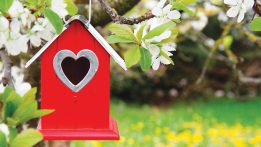Fast-moving, adaptable and aggressive, invasive plants resist efforts to eliminate or control them.
Invasive non-native plants threaten Florida’s natural areas. The plants spread quickly, unchecked by the bugs, disease and other limiting factors they face in their native lands.
Invasive non-natives can choke out native plant species and reduce natural biodiversity. Native animals – which rarely forage on non-native plants – may leave the area or die out.
You can help stem the spread of destructive non-native plants. Start by learning to recognize six species commonly found in the Florida Panhandle.
Originally from China, the mimosa has long been a fixture in Florida with its fragrant and showy pink flowers. The small- to medium-sized tree has a leaf arrangement that gives it a fern-like appearance.
The mimosa is an opportunist that spreads quickly in disturbed areas and vacant lots and along waterways. Only when mimosa is in bloom is it obvious how widespread it has become along our roadways. A member of the legume plant family, the mimosa produces numerous seeds that are flat and in pods. The seeds remain viable for years because of their tough coat.
The mimosa’s many seeds and its ability to regrow quickly when cut back make it a strong competitor to native trees and shrubs. It grows in dense stands that reduce sunlight and nutrients to other plants.
A native of Asia, coral ardisia has shiny, dark-green leaves with wavy edges and bright red berries growing underneath. Introduced to Florida in the early 1900s as an ornamental plant, the small shrub infests wooded areas in Central and North Florida.
A mature ardisia can produce a carpet of seedlings that grow into dense thickets shading out native plants and altering forest regeneration. The seeds are consumed by birds and raccoons who help them spread over wide areas.
Ardisia regrows quickly after fire or stem damage. Pulling up ardisia by the roots is likely to create perfect soil conditions for the seeds left behind.
Chinese tallow has long been popular because of its resistance to pests and colorful fall foliage. But the tree’s aggressive growth rate and adaptability to most soil types make it a serious threat to Florida’s environments.
Chinese tallow forms dense stands along ditches, coastal areas and streams. It also invades drier sites such as open fields or undisturbed forests. The tree displaces native vegetation, and its leaf litter can degrade water bodies and soil composition.
Mature trees can produce up to 100,000 seeds. Regrowth often occurs from cut stumps or roots. If your neighbor has even a single tree, prepare yourself for battling seedlings.
The Mexican petunia, with its long stalks and colorful trumpet-shaped flowers, has been a popular choice for landscapes. It blooms repeatedly and flourishes in both sun and shade, dry and wet conditions.
It is also an aggressive invader that can quickly overrun an area and crowd out competitors. It produces abundant seeds, spreads by underground runners and can re-grow when cut back or damaged by frost.
Nuisance plants are especially challenging in Florida’s abundant waterways where they disrupt navigation and flood control, interfere with recreation and harbor mosquitoes.
Water hyacinth have plagued Florida waters since the late 1800s. The floating plants form dense mats with their gaudy flowers and rounded leathery leaves. A healthy acre of water hyacinths can weigh up to 200 tons. Growth rates are explosive.
The mats limit boat traffic, block sunlight, clog water intakes and crowd out local species. As they die, water hyacinths deposit tons of rotting plant material as muck on the bottom of a waterway. The decomposition process robs the water of dissolved oxygen, killing fish and other wildlife.
Hydrilla invade springs, rivers, lakes and ditches. It is thought to have been introduced into Florida as an aquarium plant in the late 1950s, and by the 1970s was established throughout the state.
Hydrilla stems are slender, branched and up to 25 feet long. The stems can grow an inch a day and fill lakes and rivers from the bottom to the surface with a tangled mass. Hydrilla blocks sunlight and air exchange, shading out native plants and leading to fish deaths.
Over the years, government agencies have spent millions of dollars battling destructive non-native plants. How can you help?
Never release aquarium plants or animals into the wild. Stop aquatic hitchhikers by always inspecting your boat and equipment before leaving a boat ramp. Remove all animals and plants, including plant fragments.
Learn to recognize invasive non-native plants in your neighborhood, and never plant them or distribute their seeds.
It takes persistence to control invasive plants, but it can be done. After you’ve removed the invaders, return to the site and look for new growth. Another helpful move is to replant the area with non-invasive vegetation to lessen the chances of a reinvasion of nuisance non-natives or other unwanted weeds.
To learn more, visit http://plants.ifas.ufl.edu/node/21 or http://www.plantatlas.usf.edu/flip/browse.aspx?by=common. ![]()
By Susan Beason,
Florida Department of Environmental Protection










